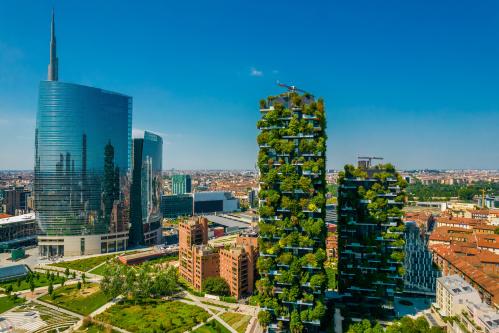Although urbanization began many millennia ago, for most of human history cities were home to the few. At the beginning of the first industrial revolution in 1765, less than 10 percent of the population lived in urban areas and economic growth largely depended on the productivity of the rural workforce. Since then, urbanization has expanded at a steady and path-breaking rate in all regions, fueled by growing demand for urban workers and technological breakthroughs such as the construction of tall buildings.
Today, more people live in urban than rural areas and growth increasingly depends on the productivity of the urban workforce. Urbanization rates are around 70 percent in the developed world and the middle-income countries in Latin America, Europe, the Middle East, and North Africa, and are rapidly climbing in the other developing economies. What forces have been shaping urban employment? Why do cities of the same size located in countries at similar income levels differ in terms of their employment composition? What are the development implications of these differences?
Economic theory provides some intuition about the differences in the employment composition along a country’s urban hierarchy by emphasizing the importance of agglomeration economies, which capture the benefits of firms from the presence of other firms in the same area. This enables the growth of cities that are competitive in the production of tradables, such as garments, electronics, and pharmaceuticals. The same agglomeration forces that allow production cities to grow big, also make it difficult for new tradable activities to grow elsewhere. Meanwhile, adjustment to adverse shocks increases the number of consumption cities in which urban residents work in retail trade and other nontradable sectors. Still, it is unclear how cities of the same population size located in countries at similar income levels differ in terms of their employment composition.
Cities around the world: consumption, production, or neutral?
We provide answers to these questions in a recent paper, which documents the employment composition of 6,865 functional urban areas, using newly available microdata for 74 countries for the period between 1960 and 2015. The selected urban areas include 3 billion people and account for three quarters of the world’s urban population. We classify each urban area as either a production city with a disproportionately high employment share in urban tradables, a consumption city with a disproportionately low employment share in urban tradables, or a neutral city in which the employment share of urban tradables is neither too low nor too high. The distribution of production (blue), consumption (red), and neutral (grey) cities, shown in Figure 1, indicates that the employment composition of cities dramatically varies across cities of similar sizes in countries at similar levels of development. Production cities are located mostly in China, Europe, India, and parts of the US, Mexico, Central America, and Brazil. Apart from some large production cities in Malaysia, Vietnam, and South Africa, other cities in Asia and Sub-Saharan Africa are either consumption or neutral cities.
Figure 1. The World Distribution of Production, Consumption, and Neutral Cities, c 2000
 Source: Jedwab, Ianchovichina, and Haslop (2022) using IPUMS census data and the Global Human Settlements Layer database. Note: Paler shades of each color indicate lower values for the extent to which a city can be classified as each specific type.
Source: Jedwab, Ianchovichina, and Haslop (2022) using IPUMS census data and the Global Human Settlements Layer database. Note: Paler shades of each color indicate lower values for the extent to which a city can be classified as each specific type.
More paths to a consumption city
There are more paths to a consumption city than to a production city. Production cities emerged with industrialization, while the “origins” of consumption cities can be traced to (i) resource rents, (ii) rents from agricultural exports in countries with sufficiently high agricultural productivity, and (iii) “premature” deindustrialization. The latter did not lead to de-urbanization, but to the de-industrialization of cities, especially the largest ones, as shown in Figure 2 for the case of Latin America.
Figure 2. Employment shares in tradables by city size and decade in Latin America
 Source: Jedwab, Ianchovichina, and Haslop (2022) using IPUMS census data and the Global Human Settlements Layer database. Note: MFGFIRE denotes manufacturing, finance, insurance, and real estate services.
Source: Jedwab, Ianchovichina, and Haslop (2022) using IPUMS census data and the Global Human Settlements Layer database. Note: MFGFIRE denotes manufacturing, finance, insurance, and real estate services.
The “origins” of urbanization matter for the largest cities
Compared to cities in the industrialized countries, cities of similar sizes in resource-rich and deindustrializing economies have lower shares of employment in manufacturing, tradable services, and the formal sector, and higher shares of employment in non-tradables and the informal sector. In the industrialized countries, the employment share of tradables is high while that of non-tradables is low across cities of all sizes. In both resource-rich and deindustrializing countries, larger cities have substantially higher shares of non-tradables than smaller cities, but for all city sizes these shares are much larger in the deindustrializing than resource-rich countries. Thus, the “origins” of urbanization matter for the largest cities, which are the nations’ leading places and engines of growth (Figure 3).
Figure 3. Employment shares by city size and origin of urbanization, c. 2000
 Source: Jedwab, Ianchovichina, and Haslop (2022) using IPUMS census data and the Global Human Settlements Layer database. Note: MFG+FIRE denotes manufacturing, finance, insurance, and real estate services; NTR2 includes wholesale and retail trade and other domestic commerce-related activities.
Source: Jedwab, Ianchovichina, and Haslop (2022) using IPUMS census data and the Global Human Settlements Layer database. Note: MFG+FIRE denotes manufacturing, finance, insurance, and real estate services; NTR2 includes wholesale and retail trade and other domestic commerce-related activities.
Trapped in consumption cities?
Having mostly consumption cities would affect the potential of developing countries to catch up to the standards of living in the advanced economies and may even explain why some countries find themselves in a middle-income trap. Agglomeration economies may be lower in countries where the share of urban employment in nontradables is disproportionately high (Venables, 2017; Burger et al., 2022). Agglomeration economies may even be “sterile” in such countries because of congestion, which may be more harmful to firms in the non-tradable sectors that benefit relatively less from supply-side agglomeration economies (Burger et al, 2022). While consumption cities do not have significantly less human capital than production cities, for a given level of human capital, consumption cities have more informality and higher employment in urban non-tradables than production cities. We also find higher wages in urban tradables than nontradables and lower returns to experience in countries with more consumption cities. This implies that human capital in consumption cities is employed in less productive sectors and jobs.
History also tells us that the employment composition of cities can dramatically change over time. The growth of many cities was initially fueled by agricultural rents and resource exports. The industrial revolutions transformed many of these consumption cities into thriving production centers. Today, countries can seize new opportunities to leverage their human capital and the technologies of the fourth industrial revolution and transform their cities into thriving production centers. To be successful, they will need to address technological skill gaps, scale up investments in digital infrastructure, and foster innovation and reforms that bolster their private sectors.









Commentary
Are cities engines of production or consumption, and does it matter?
July 14, 2022